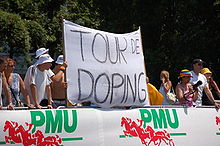
Back Dopage sur le Tour de France French Dopinga lietošana Tour de France Latvian/Lettish Doping in de Ronde van Frankrijk Dutch Doping i Tour de France NB Dopagem na Volta a França Portuguese

| Part of a series on |
| Doping in sport |
|---|
  |
There have been allegations of doping in the Tour de France since the race began in 1903. Early Tour riders consumed alcohol and used ether, among other substances, as a means of dulling the pain of competing in endurance cycling.[1] Riders began using substances as a means of increasing performance rather than dulling the senses, and organizing bodies such as the Tour and the International Cycling Union (UCI), as well as government bodies, enacted policies to combat the practice.
Use of performance-enhancing drugs in cycling predates the Tour de France. Cycling, having been from the start a sport of extremes, whether of speed by being paced by tandems, motorcycles and even cars, or of distance, the suffering involved encouraged the means to alleviate it. Not until after World War II were sporting or even particularly health issues raised. Those came shortly before the death of Tom Simpson in the Tour de France of 1967. Max Novich referred to the Tour de France in a 1973 issue of New York State Journal of Medicine as "a cycling nightmare".[2] Journalist Hans Halter wrote in 1998 that "For as long as the Tour has existed, since 1903, its participants have been doping themselves. For 60 years doping was allowed. For the past 30 years it has been officially prohibited. Yet the fact remains; great cyclists have been doping themselves, then and now."[3]
- ^ https://www.amazon.co.uk/exec/obidos/tg/feature/-/187085/202-7384003-1751816As[dead link] History, Drugs and the Tour de France by Tim Moore
- ^ Novich, Max M: Drug abuse and drugs in sports, New York State Journal of Medicine, vol 73, no 21, 1 November 1973
- ^ Halter, Hans: 'Alles verstehen, alles verzeihen', Der Spiegel, Germany 3 August 1998
© MMXXIII Rich X Search. We shall prevail. All rights reserved. Rich X Search